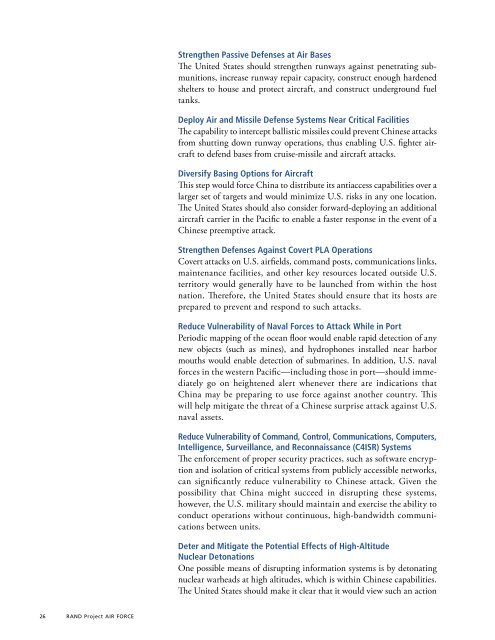RAND Project AIR FORCE Annual Report 2007 - RAND Corporation
RAND Project AIR FORCE Annual Report 2007 - RAND Corporation
RAND Project AIR FORCE Annual Report 2007 - RAND Corporation
Create successful ePaper yourself
Turn your PDF publications into a flip-book with our unique Google optimized e-Paper software.
Strengthen Passive Defenses at Air BasesThe United States should strengthen runways against penetrating submunitions,increase runway repair capacity, construct enough hardenedshelters to house and protect aircraft, and construct underground fueltanks.Deploy Air and Missile Defense Systems Near Critical FacilitiesThe capability to intercept ballistic missiles could prevent Chinese attacksfrom shutting down runway operations, thus enabling U.S. fighter aircraftto defend bases from cruise-missile and aircraft attacks.Diversify Basing Options for AircraftThis step would force China to distribute its antiaccess capabilities over alarger set of targets and would minimize U.S. risks in any one location.The United States should also consider forward-deploying an additionalaircraft carrier in the Pacific to enable a faster response in the event of aChinese preemptive attack.Strengthen Defenses Against Covert PLA OperationsCovert attacks on U.S. airfields, command posts, communications links,maintenance facilities, and other key resources located outside U.S.territory would generally have to be launched from within the hostnation. Therefore, the United States should ensure that its hosts areprepared to prevent and respond to such attacks.Reduce Vulnerability of Naval Forces to Attack While in PortPeriodic mapping of the ocean floor would enable rapid detection of anynew objects (such as mines), and hydrophones installed near harbormouths would enable detection of submarines. In addition, U.S. navalforces in the western Pacific—including those in port—should immediatelygo on heightened alert whenever there are indications thatChina may be preparing to use force against another country. Thiswill help mitigate the threat of a Chinese surprise attack against U.S.naval assets.Reduce Vulnerability of Command, Control, Communications, Computers,Intelligence, Surveillance, and Reconnaissance (C4ISR) SystemsThe enforcement of proper security practices, such as software encryptionand isolation of critical systems from publicly accessible networks,can significantly reduce vulnerability to Chinese attack. Given thepossibility that China might succeed in disrupting these systems,however, the U.S. military should maintain and exercise the ability toconduct operations without continuous, high-bandwidth communicationsbetween units.Deter and Mitigate the Potential Effects of High-AltitudeNuclear DetonationsOne possible means of disrupting information systems is by detonatingnuclear warheads at high altitudes, which is within Chinese capabilities.The United States should make it clear that it would view such an action26 <strong>RAND</strong> <strong>Project</strong> <strong>AIR</strong> <strong>FORCE</strong>
















